Related Research Articles

The Great Belt Bridge or Great Belt fixed link is a multi-element fixed link crossing the Great Belt strait between the Danish islands of Zealand and Funen. It consists of a road suspension bridge and a railway tunnel between Zealand and the small island Sprogø in the middle of the Great Belt, and a box-girder bridge for both road and rail traffic between Sprogø and Funen. The total length is 18 kilometres (11 mi).

The Copenhagen Metro is a 24/7 light rapid transit system in Copenhagen, Denmark, serving the municipalities of Copenhagen, Frederiksberg, and Tårnby.
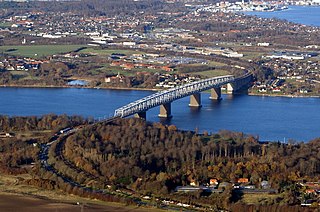
The Little Belt Bridge, also known as the Old Little Belt Bridge, is a truss bridge over the Little Belt strait in Denmark. It spans from Snoghøj on the Jutland side to Middelfart on Funen.

The rail transport system in Denmark consists of 2,633 km of railway lines, of which the Copenhagen S-train network, the main line Helsingør-Copenhagen-Padborg, and the Lunderskov-Esbjerg line are electrified. Most traffic is passenger trains, although there is considerable transit goods traffic between Sweden and Germany.

Banedanmark is a Danish company that is responsible for the maintenance and traffic control on all of the state owned Danish railway network.

The Fehmarn Belt fixed link or Fehmarn Belt tunnel is an under-construction immersed tunnel, which will connect the Danish island of Lolland with the German island of Fehmarn, crossing the 18-kilometre-wide (11 mi) Fehmarn Belt in the Baltic Sea.

The City Circle Line or M3 is a loop line of the Copenhagen Metro. It has been claimed by COWI A/S that the City Circle Line is the largest construction project to have taken place in Copenhagen during the last 400 years. The network's total length is 15.5 kilometres (9.6 mi) and has 17 stations. The line opened on 29 September 2019.
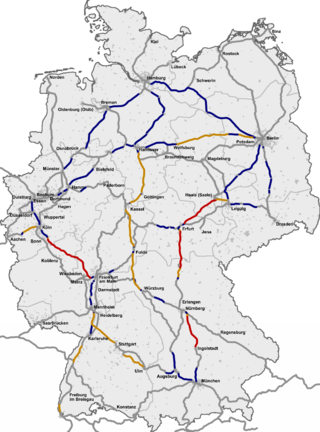
Construction of the first high-speed rail in Germany began shortly after that of the French LGVs. However, legal battles caused significant delays, so that the German Intercity-Express (ICE) trains were deployed ten years after the TGV network was established. Germany has around 1,658 kilometers of high speed lines.

The Vogelfluglinie (German) or Fugleflugtslinjen (Danish) is a transport corridor between Copenhagen, Denmark, and Hamburg, Germany.
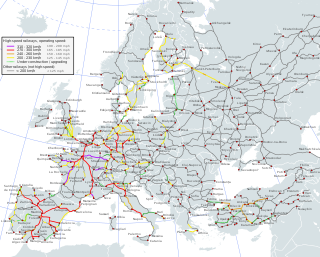
High-speed rail (HSR) has developed in Europe as an increasingly popular and efficient means of transport. The first high-speed rail lines on the continent, built in the 1970s, 1980s, and 1990s, improved travel times on intra-national corridors. Since then, several countries have built extensive high-speed networks, and there are now several cross-border high-speed rail links. Railway operators frequently run international services, and tracks are continuously being built and upgraded to international standards on the emerging European high-speed rail network.

In Sweden many trains run at 200 km/h (125 mph). Train types which currently attain this speed include the X 2000 tilting trains for long distances, the Regina widebody trains, the X40 double-decker regional trains, the Arlanda Airport Express X3, the MTRX-trains, FlixTrains and the Stadler KISS-inspired double-decker regional trains. Since both the X2 and X3 are allowed to run at 205 km/h (127 mph) in case of delay, they can technically be considered as high-speed trains. The X2 runs between many cities in Sweden including Stockholm, Gothenburg, and Malmö. The Arlanda Express trains connect Stockholm and Stockholm-Arlanda Airport.

Odense Station is the main railway station serving the city of Odense, Denmark. It is located in central Odense, on the northern edge of the historic town centre, and lies immediately adjacent to the Odense bus station and a stop on the Odense Tramway.
Nordvestfyenske Jernbane was a Danish railway from Odense to Middelfart via Brenderup, with a branch from Brenderup to Bogense.

The Copenhagen–Ringsted line is a high-speed railway on Zealand, Denmark, connecting Copenhagen via Køge with Ringsted. The line was inaugurated on 31 May 2019, and started operating on 1 June as the first high-speed railway in Denmark. It supports speeds of up to 250 km/h (155 mph) for passenger trains as well as a maximum of 24 trains per hour along its length. As of 2023, the speed limit is 200 km/h.
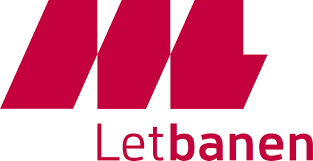
The Aarhus Letbane is a light rail system in the city of Aarhus, Denmark. It is operated by the company Midttrafik. The first line opened in December 2017, but the system is under continuous development and expansion. Service on the intercity section Odder to Lisbjergskolen opened on August 25, 2018. A third intercity line to Grenå opened on 30 April 2019. More lines are being planned.

The first high-speed railway in Denmark was the Copenhagen–Ringsted Line, completed in late 2018 and opened in 2019. Further high-speed lines are currently under planning.

The Odense Letbane is a tram system in Odense, Denmark. The first phase opened on 28 May 2022. The tramway starts in Tarup, in the north-western part of Odense, and travels via the central train station, University of Southern Denmark, and the new hospital before reaching its final destination in Hjallese, in the southernmost part of the city. The first line consists of 14.5 kilometres (9.0 mi) of tracks and has 26 stations. Expected number of passengers is 34,000 daily. The total budget is 3.3 billion Danish krone. The tramway is financed by the Odense Municipality, the Danish State, and the Region of Southern Denmark.
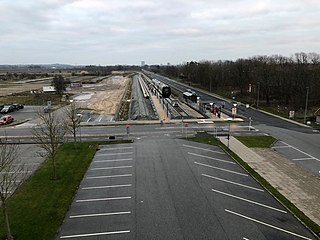
The Aalborg Airport railway line is a branch line railway in North Jutland, Denmark that links the city of Aalborg with its airport. The 2.8 km (1.7 mi) long standard gauge single track railway line opened in 2020.

Østbanen is a Danish local railway in the eastern part of Zealand. Østbanen started operations on 1 July 1879. It is today part of Lokaltog, a railway company operating nine local railways on the islands of Zealand, Lolland and Falster.
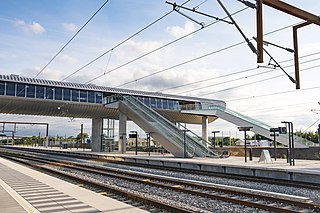
Køge North station is an Intercity, regional and S-train railway station that is located in the northern part of the city of Køge, Denmark. It opened on 1 June 2019 and is located about 35 km southwest of Copenhagen. The station and the Copenhagen–Ringsted Line constitute part of the Fehmarn Belt connection to Germany, and also the main line to western Denmark. It will allow passengers to change trains between high-speed rail services and S-trains, as well as regional services. Crown Prince Frederik inaugurated the station on 31 May 2019.
References
- 1 2 "Regeringen sætter 147 millioner af til vestfynsk jernbane - TV 2". nyheder.tv2.dk (in Danish). TV2. 30 September 2019. Archived from the original on 18 October 2019. Retrieved 29 April 2020.
- ↑ "Danish parliament approves revised Togfond plan". 11 September 2017. Retrieved 27 September 2020.
- ↑ "Danish parliament approves Vestfyn fast line". Railway Gazette International. 21 November 2019. Retrieved 27 September 2020.
- ↑ "S-tog skal betjene Vestfyn: Zofuz og Poul vil have sat fut i by". fyens.dk. 18 October 2019. Retrieved 27 September 2020.
- ↑ "Totalrådgivning af ny jernbane over Vestfyn". NIRAS. 2022-05-20.